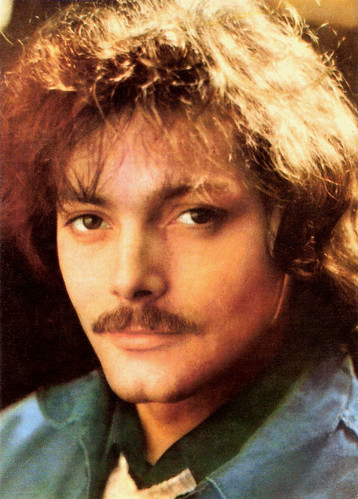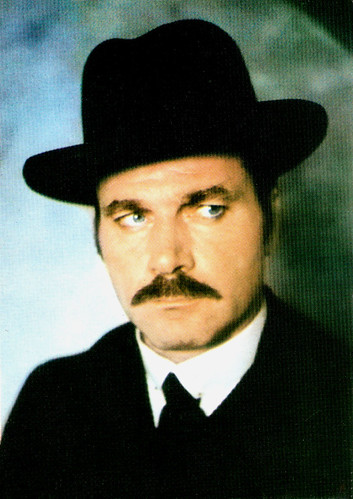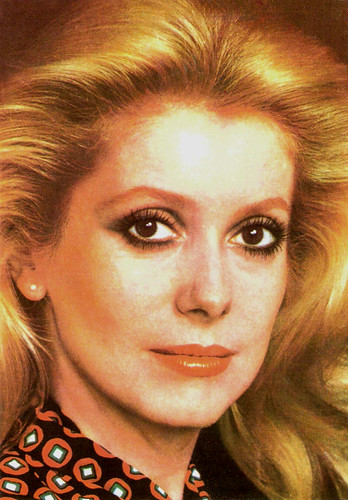French actor Patrick Dewaere (1947-1982) was a promising and popular European film star in the 1970s. In 1982, the actor shot himself. He was only 35 years old.

Rumanian postcard by Casa Filmului Acin, no. cd. 43 157.

French postcard by Editions F. Nugeron, Tessancourt, no. R 5B.

French postcard by Editions Humour à la Carte, Paris, no. 3735.
Patrick Dewaere was born Patrick Jean Marie Henri Bourdeaux in Saint-Brieuc in Britanny, in the northwest region of France, in 1947. He was the third of six children of actress Mado Maurin. His five siblings, Jean-Pierre Maurin (1941-1996), Yves-Marie Maurin (1944), Dominique Maurin (1949), Jean-Francois Maurin (1957) and Marie-Veronique Maurin (1960), all became actors, with varying degrees of success.
Patrick made his film debut at the age of four under the name Patrick Maurin in Monsieur Fabre/Amazing Monsieur Fabre (Henri Diamant Berger, 1951) featuring Pierre Fresnay. More small film roles followed in La Madelon (Jean Boyer, 1954) with Line Renaud, and En effeuillant la marguerite/Plucking the Daisy (Marc Allégret, 1956) starring Brigitte Bardot and Daniel Gélin.
Taunted by his schoolyard friends for his young film endeavours, he learned sensitivity and isolation at an early age. Other films during this period included Gene Kelly's The Happy Road (1957) and the comedy Mimi Pinson (Robert Darène, 1958) with Dany Robin.
As a young adult in the early 1960s, Patrick appeared on French television and in the star-studded war film Paris brûle-t-il?/Is Paris burning? (René Clément, 1966). In 1968, he joined the Café de la Gare, an experimental theatre troupe where he remained for nearly a decade. The performers also included such future stars as Gérard Depardieu and Miou-Miou.
He became romantically involved with Miou-Miou. A child, Angèle Herry-Leclerc, was born to this liaison in 1974, but the couple broke up after only two years. After initially appearing under the pseudonym Patrick Maurin, he finally opted for Dewaere, which was his grandmother's maiden name. In this period he played small parts in films. The best was the art-house hit Themroc (Claude Faraldo, 1973), an absurdist black comedy starring Michel Piccoli as an urban caveman.

Vintage French press photo. Patrick Dewaere and Philippe Léotard in Le juge Fayard dit le Sheriff/Judge Fayard Called the Sheriff (Yves Boisset, 1977).

French postcard in the Le Monde Vécu series by Editions SEPPMG, Paris, Serie 3D, no. 000012. Caption. "The Living World". Patrick Dewaere, 16 July 1982. Farewell Patrick Dewaere.
Patrick Dewaere made his breakthrough in the cinema with his major role in Bertrand Blier's anarchic comedy Les Valseuses/Going Places (1974). Gérard Depardieu and Dewaere played two young rebellious petty thugs who team up with Miou-Miou. The three earned instant ‘anti-hero’ stardom with their roles. He followed this with the romantic comedy Lily, aime-moi (Maurice Dugowson, 1975), and the crime drama Adieu, poulet/The French Detective (Pierre Granier-Deferre, 1975) as Lino Ventura's sidekick.
Despite Dewaere's obvious talent for comedy, he was often successfully cast as a fragile, neurotic individual. He earned marks for his off-balanced role in La meilleure façon de marcher/The Best Way to Walk (Claude Miller, 1976). In Italy he appeared in Marcia trionfale/Victory March (Marco Bellocchio, 1976) with Michele Placido and Franco Nero, and in L'ingorgo - Una storia impossibile/Black Out in Autostrada (Luigi Comencini, 1979) about the biggest traffic jam ever seen.
He starred again with Depardieu in Blier's Oscar-winning cross-over comedy Préparez vos mouchoirs/Get Out Your Handkerchiefs (Bertrand Blier, 1978). Gary Brumburgh writes at IMDb: “Infinitely more interested in searching out complex roles than fame, his work in films were more often than not experimental, low budget and quirky in style. He appeared innately drawn to playing sensitive, scruffy, miserable neurotics, misfits and losers.“ Examples are his characters in the soccer drama Coup de tête/Hothead (Jean-Jacques Annaud, 1979), the detective Série noire (1979, Alain Corneau), Un mauvais fils/A Bad Son (Claude Sautet, 1980), Hôtel des Amériques/Hotel America (André Téchiné, 1981) with Catherine Deneuve, and the critically-acclaimed Beau-père/Stepfather (Bertrand Blier, 1981).
Unlike his counterpart Depardieu, Patrick's fame never branched out to Hollywood, but he was recognized consistently for his superlative portrayals. Amazingly, he was nominated for seven César awards (the French Oscar) but never won. Shortly after the release of Paradis Pour Tous/Paradise for All (Alain Jessua, 1982), a black comedy where his character suffers from depression and commits suicide, the actor shot himself with a rifle in a Paris hotel.
Patrick Dewaere was 35 years old. At the time he was working on Claude Lelouch's film Édith et Marcel/Edith and Marcel (1983). A shocking, inexplicable end to friends, fans and family alike. For eleven years Dewaere was married to French actress Sotha. They had one daughter, Lola. A year after his death, the Patrick Dewaere Award was established in France. The actor was the subject of the French documentary Patrick Dewaere, which was shown at the 1992 Cannes Film Festival.

Franco Nero. Rumanian postcard by Casa Filmului Acin.

Catherine Deneuve. Rumanian postcard by Casa Filmului Acin.

East German postcard by VEB Progress Film-Verleih, Berlin, no. 98/78. Photo: Unifrance.
Sources: Yuri German (AllMovie), Gary Brumburgh (IMDb), Wikipedia and IMDb.

Rumanian postcard by Casa Filmului Acin, no. cd. 43 157.

French postcard by Editions F. Nugeron, Tessancourt, no. R 5B.

French postcard by Editions Humour à la Carte, Paris, no. 3735.
Sensitivity and isolation
Patrick Dewaere was born Patrick Jean Marie Henri Bourdeaux in Saint-Brieuc in Britanny, in the northwest region of France, in 1947. He was the third of six children of actress Mado Maurin. His five siblings, Jean-Pierre Maurin (1941-1996), Yves-Marie Maurin (1944), Dominique Maurin (1949), Jean-Francois Maurin (1957) and Marie-Veronique Maurin (1960), all became actors, with varying degrees of success.
Patrick made his film debut at the age of four under the name Patrick Maurin in Monsieur Fabre/Amazing Monsieur Fabre (Henri Diamant Berger, 1951) featuring Pierre Fresnay. More small film roles followed in La Madelon (Jean Boyer, 1954) with Line Renaud, and En effeuillant la marguerite/Plucking the Daisy (Marc Allégret, 1956) starring Brigitte Bardot and Daniel Gélin.
Taunted by his schoolyard friends for his young film endeavours, he learned sensitivity and isolation at an early age. Other films during this period included Gene Kelly's The Happy Road (1957) and the comedy Mimi Pinson (Robert Darène, 1958) with Dany Robin.
As a young adult in the early 1960s, Patrick appeared on French television and in the star-studded war film Paris brûle-t-il?/Is Paris burning? (René Clément, 1966). In 1968, he joined the Café de la Gare, an experimental theatre troupe where he remained for nearly a decade. The performers also included such future stars as Gérard Depardieu and Miou-Miou.
He became romantically involved with Miou-Miou. A child, Angèle Herry-Leclerc, was born to this liaison in 1974, but the couple broke up after only two years. After initially appearing under the pseudonym Patrick Maurin, he finally opted for Dewaere, which was his grandmother's maiden name. In this period he played small parts in films. The best was the art-house hit Themroc (Claude Faraldo, 1973), an absurdist black comedy starring Michel Piccoli as an urban caveman.

Vintage French press photo. Patrick Dewaere and Philippe Léotard in Le juge Fayard dit le Sheriff/Judge Fayard Called the Sheriff (Yves Boisset, 1977).

French postcard in the Le Monde Vécu series by Editions SEPPMG, Paris, Serie 3D, no. 000012. Caption. "The Living World". Patrick Dewaere, 16 July 1982. Farewell Patrick Dewaere.
Instant anti-hero stardom
Patrick Dewaere made his breakthrough in the cinema with his major role in Bertrand Blier's anarchic comedy Les Valseuses/Going Places (1974). Gérard Depardieu and Dewaere played two young rebellious petty thugs who team up with Miou-Miou. The three earned instant ‘anti-hero’ stardom with their roles. He followed this with the romantic comedy Lily, aime-moi (Maurice Dugowson, 1975), and the crime drama Adieu, poulet/The French Detective (Pierre Granier-Deferre, 1975) as Lino Ventura's sidekick.
Despite Dewaere's obvious talent for comedy, he was often successfully cast as a fragile, neurotic individual. He earned marks for his off-balanced role in La meilleure façon de marcher/The Best Way to Walk (Claude Miller, 1976). In Italy he appeared in Marcia trionfale/Victory March (Marco Bellocchio, 1976) with Michele Placido and Franco Nero, and in L'ingorgo - Una storia impossibile/Black Out in Autostrada (Luigi Comencini, 1979) about the biggest traffic jam ever seen.
He starred again with Depardieu in Blier's Oscar-winning cross-over comedy Préparez vos mouchoirs/Get Out Your Handkerchiefs (Bertrand Blier, 1978). Gary Brumburgh writes at IMDb: “Infinitely more interested in searching out complex roles than fame, his work in films were more often than not experimental, low budget and quirky in style. He appeared innately drawn to playing sensitive, scruffy, miserable neurotics, misfits and losers.“ Examples are his characters in the soccer drama Coup de tête/Hothead (Jean-Jacques Annaud, 1979), the detective Série noire (1979, Alain Corneau), Un mauvais fils/A Bad Son (Claude Sautet, 1980), Hôtel des Amériques/Hotel America (André Téchiné, 1981) with Catherine Deneuve, and the critically-acclaimed Beau-père/Stepfather (Bertrand Blier, 1981).
Unlike his counterpart Depardieu, Patrick's fame never branched out to Hollywood, but he was recognized consistently for his superlative portrayals. Amazingly, he was nominated for seven César awards (the French Oscar) but never won. Shortly after the release of Paradis Pour Tous/Paradise for All (Alain Jessua, 1982), a black comedy where his character suffers from depression and commits suicide, the actor shot himself with a rifle in a Paris hotel.
Patrick Dewaere was 35 years old. At the time he was working on Claude Lelouch's film Édith et Marcel/Edith and Marcel (1983). A shocking, inexplicable end to friends, fans and family alike. For eleven years Dewaere was married to French actress Sotha. They had one daughter, Lola. A year after his death, the Patrick Dewaere Award was established in France. The actor was the subject of the French documentary Patrick Dewaere, which was shown at the 1992 Cannes Film Festival.

Franco Nero. Rumanian postcard by Casa Filmului Acin.

Catherine Deneuve. Rumanian postcard by Casa Filmului Acin.

East German postcard by VEB Progress Film-Verleih, Berlin, no. 98/78. Photo: Unifrance.
Sources: Yuri German (AllMovie), Gary Brumburgh (IMDb), Wikipedia and IMDb.
No comments:
Post a Comment